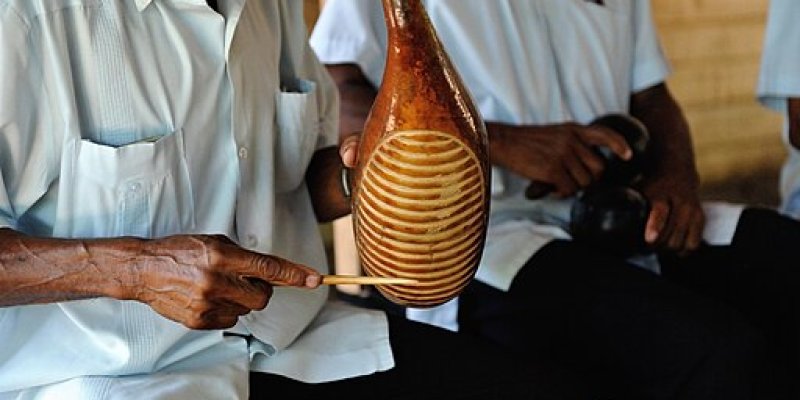
Okay, so let's start at the beginning. What on earth is a guiro?
The guiro is a percussion instrument that belongs to the idiophone family. It typically consists of a hollow, cylindrical or rectangular-shaped tube with parallel ridges or notches carved into its surface.
The player uses a stick, called a "pua," to rub or strike the ridges, producing a distinctive scraping or rattling sound. It's a rhythmic force to be reckoned with.
It's like painting music with your hands, adding texture and flavor to the composition. The guiro's distinct scraping and rattling sound make it instantly recognizable in various genres of music.
The guiro's history traces back to the indigenous cultures of the Caribbean, with the Taíno and Ciboney being early adopters of this instrument. Some say that the history goes back to slaves in Africa who brought it to the Caribbean.
Over time, the guiro made its way into various musical genres, such as Afro-Caribbean, Latin American, and even Western music.
Its rhythmic prowess and unique sound captured the attention of musicians and listeners alike, leading to its integration into diverse musical traditions.
Guiros come in various designs, reflecting the diverse cultural contexts in which they are used. Traditionally, guiros were crafted from natural materials such as gourds, wood, or even bone.
These materials were carefully hollowed out, creating a resonant chamber. The surface of the guiro was adorned with carved ridges or notches, which are crucial for producing its characteristic sound.
The shape, size, and placement of these ridges can vary, affecting the instrument's pitch and tonal qualities.
In modern times, guiros are also made using materials like fiberglass or plastic. These materials offer durability and consistency in sound, making them popular choices for professional musicians and enthusiasts.
However, some purists still prefer the traditional craftsmanship and organic feel of guiros made from natural materials.
Related Post: Pitch Vs. Tone - Understanding The Difference In Terms
The guiro's rhythmic magic knows no boundaries when it comes to cultural embrace. In the Caribbean, it plays a significant role in genres such as merengue, salsa, reggaeton, and more.
These vibrant musical styles thrive on the energetic pulse created by the guiro. In Latin American countries like Puerto Rico, the Dominican Republic, and Cuba, the guiro is deeply woven into the fabric of their traditional folk music.
Whether it's the lively beats of the Puerto Rican plena or the Afro-Cuban rhythms of the son, the guiro adds its distinct flavor to the music, creating an irresistible groove that compels people to dance.
But the influence of the guiro extends far beyond its Caribbean roots. It has found a place in popular music genres worldwide, transcending cultural borders.
In the realm of pop music, artists like Ricky Martin, Carlos Santana, and Gloria Estefan have incorporated the guiro into their songs, infusing them with a touch of Latin flair.
The guiro's ability to blend seamlessly with various musical styles demonstrates its versatility and universal appeal.
Classics like "Suavemente" by Elvis Crespo, "Oye Como Va" by Tito Puente, and "Pedro Navaja" by Rubén Blades showcase the guiro's rhythmic prowess.
These songs are filled with energy, and the guiro adds that extra layer of excitement and drive.
In the realm of pop music with a little Latin flavor, who can resist the catchy tunes of "La Bamba" by Ritchie Valens or "Livin' La Vida Loca" by Ricky Martin?
Whether it's the dance floor or your living room, the guiro's presence in these songs elevates the overall experience and gets everyone moving.
Related Post: 8 Ideas For Naming Your Music Instrument
Hold the guiro firmly in one hand while using the other hand to play. Experiment with different grips and find what feels comfortable for you.
When using the scraper or stick (pua), apply light to moderate pressure against the ridges to produce a clear and consistent sound. Remember to maintain a relaxed grip to allow for fluid movements.
The guiro offers a range of playing techniques. Experiment with various strokes, such as short and quick scrapes, long and smooth scrapes, or even tapping the ridges with the pua.
This experimentation will help you discover different tones and textures that the guiro can produce, adding depth to your playing.
Focus on developing a steady sense of rhythm and timing. Listen to the beat of the music and try to synchronize your guiro playing with it.
Start by practicing simple patterns and gradually increase the complexity as you gain more confidence. Don't be afraid to explore and improvise, as the guiro's rhythmic nature allows for creative expression.
The guiro is often used in ensemble settings, so take the opportunity to jam and collaborate with other musicians.
Explore how the guiro complements other instruments and learn to play in sync with different rhythms and melodies. It's a great way to expand your musical horizons and develop your ability to groove within a group.
Related Post: What Instrument Should You Play? Several Choices That May Fit Your Style

As a session singer, writer, and producer that has worked with over 300 clients to provide high-quality jingles, singles, and features, Yona spends her time creating and marketing new music and helpful resources for creators. Check out Yona’s latest releases on her Spotify, her Youtube and share if you like it!
If you are in need of singer, songwriter or song producer services, see what Yona Marie can offer you on her services page.